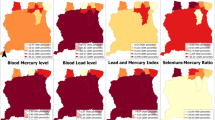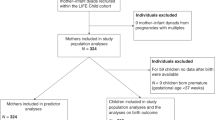Abstract
This project was initiated by the North America Commission for Environmental Cooperation (CEC). Its main purpose was to obtain an initial profile on pregnant woman's exposure to persistent organic pollutants (POPs) in North America (Canada, the United States and Mexico). Persistent organic pollutants are transferred to the fetus via the placenta during the pregnancy or to the infant via maternal milk; therefore, the pregnant woman's body burden is important because of the higher exposures and potential health effects in the fetus and infant. This paper presents the results from 240 pregnant women in 10 Mexican cities, and includes the concentrations of various POPs such as polychlorinated biphenyls (PCBs), organochlorine pesticides and polychlorinated dibenzo dioxins and furans (PCDDs and PCDFs) in maternal plasma. We found concentrations of p,p′-DDE in maternal samples from Coatzacoalcos to be ∼60% higher than those found in Ciudad Obregon, which had the second highest concentration. Pregnant women from Merida had higher mean concentrations of PCBs than all women in other regions. Results for PCDDs and PCDFs plus dioxin-like PCBs data were only available on the basis of composite samples, and their concentrations are similar in most cities except for Coatzacoalcos, which had more than double the concentration found in other cities. Although this study provides useful information on the variability of POPs in specific populations and possible regional/local differences, these results cannot be generalized to the entire Mexican population because of differences in age, gender, sources of exposure and nonrandom nature of the sample.
This is a preview of subscription content, access via your institution
Access options
Subscribe to this journal
Receive 6 print issues and online access
$259.00 per year
only $43.17 per issue
Buy this article
- Purchase on Springer Link
- Instant access to full article PDF
Prices may be subject to local taxes which are calculated during checkout

Similar content being viewed by others
References
Albert L. Persistent pesticides in Mexico. Rev Environ Contam Toxicol 1996: 147: 141–144.
Albert L. Compuestos Orgánicos Persistentes. In: Ambiental-Albert LA, (Ed.) Toxicología. Universidad Autónoma de Ciudad Juárez, Ciudad Juárez Chihuahua México, 2004 pp. 377–402.
Atkins J.R., Waldrep K., and Bernet Jr J.T. The estimation of total serum lipids by a completely enzymatic “summation” method. Clin Chim Acta 1989: 184: 219–226.
Centro Nacional de Salud Ambiental. Centro de Vigilancia Epidemiológica. Situación actual de la malaria y el uso de DDT en México. Secretaria de Salud, Mexico DF, 2000.
Commission for Environmental Cooperation. The Sound Management of Chemicals (SMOC) initiative of the Commission for Environmental Cooperation of North America. Overview and Update 2003: Commission for Environmental Cooperation (CEC).
Dewey K.G., Heinig M.J., Nommsen L.A., Peerson J.M., and Lonnerdal B. Growth of breast-fed and formula-fed infants from 0 to 18 months: the DARLING Study. Pediatrics 1992: 89: 1035–1041.
Doucet J., Tague B., Arnold D., Cooke G.M., Hayward S., and Goodyer C. Persistent organic pollutant residues in human fetal liver and placenta from Greater Montreal, Quebeb: a longitudinal study from 1998 through 2006. Environ Health Perspect 2009: 117: 605–610.
Eskenazi B., et al. Maternal serum dioxin levels in birth outcomes in women of Seveso, Italy. Environ Health Perspect 2003: 111: 947–953.
Ferriby L.L., et al. Evaluation of PCDD/F and dioxin-like PCB serum concentration data from the 2001–2002 National Health and Nutrition Examination Survey of United States Citizens. J Expo Sci Environ Epidemiol 2007: 17: 358–371.
Flores-Luevano S., et al. [DDT/DDE concentrations and risk of hypospadias. Pilot case-control study]. Salud Pública Mex 2003: 45: 431–438.
Giesy J., and Kannan K. Dioxine-like and non-dioxin-like toxic effects of polychlorinated biphenyls (PCBs): implications for risk assessment. Crit Rev Toxicol 1998: 28: 511–569.
Gobierno Federal. Desarrrollo Sustentable. Tercer Informe de Gobierno. http://tercer.informe.calderon.presidencia.gob.mx/informe/pdf/4_7.pdf (accessed 26 July 2010) (Type of Medium) 2009.
Guvenius D.M., Aronsson A., Ekman-Ordeberg G., Bergman A., and Norén K. Human prenatal and postnatal exposure to polybrominated diphenyl ethers, polychlorinated biphenyls, polychlorobiphenylols, and pentachlorophenol. Environ Health Perspect 2003: 111: 1235–1241.
Harden F.A., Toms L.M., Paepke O., Ryan J.J., and Müller J.F. Evaluation of age, gender and regional concentration differences for dioxin-like chemicals in the Australian population. Chemosphere 2007: 67: 318–324.
Hedgeman E., et al. The university of Michigan dioxin study: population survey results and serum concentrations for polychlorinated dioxine, furans and biphenyls. Environ Health Perspect 2009: 117: 811–817.
Instituto de Salud Ambiente y Trabajo. Nomination Dossier for hexachlorobenzene: submitted by Mexico to the Sound Management of Chemicals (SMOC) Working Group. http://www.cec.org/files/pdf/POLLUTANTS/hcbmex_en.PDF (accessed 8 November 2010) (Type of Medium) 1998.
Koepke R., et al. Serum DDT and DDE levels in pregnant women of Chiapas, Mexico. Arch Environ Health 2004: 59: 559–565.
Liu S., Li S., and Du Y. Polychlorinated biphenyls (PCBs) enhance metastatic properties of breast cancer cells by activating rho-associated kinase (ROCK). PLos ONE 2010: 5: e11272.
Longnecker M.P., et al. In utero exposure to the antiandrogen 1,1-dichloro-2,2-bis(p-chlorophenyl)ethylene (DDE) in relation to anogenital distance in male newborns from Chiapas, Mexico. Am J Epidemiol 2007: 165: 1015–1022.
López-Carrillo L., López-Cervantes M., Torres-Sánchez L., Blair A., Cebrián M., and García R. Serum levels of beta-hexachlorocyclohexane, hexachlorobenzene and polychlorinated biphenyls and breast cancer in Mexican women. Eur J Cancer Prev 2002: 11: 129–135.
Lopez-Carrillo L., Torres-Sanchez L., Moline J., Ireland K., and Wolff M.S. Breast-feeding and serum p,p’DDT levels among Mexican women of childbearing age: a pilot study. Environ Res 2001: 87: 131–135.
López-Carrillo L., et al. Is DDT use a public health problem in Mexico? Environ Health Perspect 1996: 104: 584–588.
Mes J. Organochlorine residues in adipose tissue of Canadians bull. Environ Contam Toxicol 1990: 45: 681–688.
Pan American Health Organization. Status of Malaria Programs in the Americas. PAHO, Washington, 1992.
Park J., Linderholm L., Charles M.J., Athanasiadou M., Petrik J., and Kokan A. Polychlorinated biphenyls and their hydroxylated metabolites (OH-PCBSs) in pregnant women from Eastern Slovakia. Environ Health Perspect 2007: 115: 20–27.
Patterson D.J., Hampton L., Lapeza C.J., Belser W., Green V., and Alexander L. High resolution gas chromatographic/high resolution mass spectrometric analysis of human serum on a whole weight and lipid basis for 2,3,7,8 TCDD. Anal Chem 1987: 59: 2000–2005.
Portillo-Galván M., Jiménez-Gutierrez C., Torres Sánchez L., and Lopez-Carrillo L. [Food consumption and adipose tissue DDT levels in Mexican women]. Cad Saúde Pública 2002: 18: 447–452.
Schulz D.P., Patrick G., and Duiker J.C. Complete characterization of polychlorinated biphenyl congeners in commercial Aroclor and clophen mixtures by multidimensional gas chromatography-electron capture detection. Eviron Sci Technol 1989: 23: 852–859.
Secretaria de Medio Ambiente y Recursos Naturales. Plan Nacional de Implementación del Convenio de Estocolmo. Secretaria de Medio Ambiente y Recursos Naturales, México, 2007.
Seelbach M., et al. Polychlorinated biphenyls disrupt blood–brain barrier integrity and promote brain metastasis formation. Environ Health Perspect 2010: 118: 479–484.
Solomon G.W., and Weiss P.M. Chemical contaminants in breast milk: time trends region variability. Environ Health Perspect 2002: 110: A339–A347.
Todaka T., et al. Relationship between the concentrations of polychlorinated dibenzo-p-dioxins polychlorinated dibenzofurans, and polychlorinated biphenyls in maternal blood and those in breast milk. Chemosphere 2010: 78: 185–192.
Torres-Sanchez L., and Lopez-Carrillo L. [Human health effects and p,p’-DDE and p,p’-DDT exposure: the case of Mexico]. Cien Saude Colet 2007: 12: 51–60.
Torres-Sanchez L., et al. In utero p,p’-DDE exposure and infant neurodevelopment: a perinatal cohort in Mexico. Environ Health Perspect 2007: 115: 435–439.
Torres-Sanchez L., et al. Prenatal dichlorodiphenyldichloroethylene (DDE) exposure and neurodevelopment: a follow-up from 12 to 30 months of age. Neurotoxicology 2009: 30: 1162–1165.
Trichopoulus D., Adami H.O., Hsieh C.C., Baron J., and Lipworth L., et al. Organochlorine compounds in relation to breast cancer, endometrial cancer, and endiometrosis: an assesmment of the biological and epidemiological evidence. Crit RevToxicol 1995: 25: 463–531.
Turner W., DiPrieto E., Lapeza C., Green V., Gill J., and DG Jr P. A fast universal automated cleanup system for the isotope-dilution high-resolution mass spectrometric analysis of PCDDs, PCDFs, coplanar PCBs, PCB congeners, and persistent pesticides from the same serum sample. Organohalogen Compd 1997: 31: 26–31.
Van den Berg M., et al. The 2005 World Health Organization re-evaluation of human and mammalian toxic equivalency factors for dioxins and dioxin-like compounds. Toxicol Sci 2006: 93: 223–241.
Van Oostdam J., and Donaldson, S.G. Human tissue levels of environmental contaminants. In: Hansen JC, Van Oostdam, Gilman A, Odland JO, Vaktskjold A, Dudarev A, (Eds.) In AMAP Assessment 2009. Human Health in the Arctic. Arctic Monitoring and Assessment Programme (AMAP), Oslo, Norway, 2009 pp. 61–100.
Wang R.Y., Jain R.B., Wolking A.F., Rubin C.H., and Needham L.L. Serum concentrations of selected persistent organic pollutants in a sample of pregnant females and changes in their concentrations during gestation. Environ Health Perspect 2009: 117: 1244–1249.
Westgard J. Basic QC Practices: Training in Statistical Quality Control for Health Care Laboratories Inc., Westgard QC, Madison, WI, 2002.
Woodruff T.J., Zota A.R., and Schwartz J.M. Environmental chemicals in pregnant women in the US:NHANES 2003–2004. Environ Health Perspect 2011: 119: 1023–1028.
World Health Organization. Obesity: Preventing And Managing The Global Epidemic. In: Report of a WHO Consultation Presented at: The World Health Organization Geneva, Switzerland, 1997.
Yañez L., Ortiz-Pérez D., Batres Lilia E., Borja Aburto V., and Diaz-Barriga F. Levels of dichlorodiphenyltrichloroethane and deltametrhin in humans and environmental samples in malarious areas of Mexico. Environ Res 2002: 88: 174–181.
Acknowledgements
This study was supported by the Commission for Environmental Cooperation (Montreal, Canada) and by the World Bank (Geneva, Switzerland).We thank to the executive chiefs and staff from: Hospital de Especialidades del niño y la mujer Querétaro, Hospital General de Cuautitlán, Centro de Salud de la Cabecera Municipal de Tultitlán Centro, Hospital Materno Infantil Mérida, Hospital General Coatzacoalcos, Hospital Universitario Monterrey, Hospital Integral Hermosillo, Hospital Zona “Yanga”, “Hospital General Ciudad Obregón, Hospital Civil Guadalajara and the mothers who participated in this study.
Author information
Authors and Affiliations
Corresponding author
Ethics declarations
Competing interests
The authors declare no conflict of interest.
Rights and permissions
About this article
Cite this article
Rodríguez-Dozal, S., Riojas Rodríguez, H., Hernández-Ávila, M. et al. Persistent organic pollutant concentrations in first birth mothers across Mexico. J Expo Sci Environ Epidemiol 22, 60–69 (2012). https://doi.org/10.1038/jes.2011.31
Received:
Accepted:
Published:
Issue Date:
DOI: https://doi.org/10.1038/jes.2011.31
Keywords
This article is cited by
-
Cumulative Chemical Exposures During Pregnancy and Early Development
Current Environmental Health Reports (2015)



